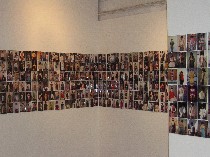 Without the money to bring in out-of-town talent and cover their and her own costs, and without the money to pay herself for her time and energy spent mounting a show, Kait Midgett says she’s about to give up the Project Room, her off-beat gallery at 8th and Girard that has given artists room to experiment and stretch their limits for the past five years (image top, installation shot of Susan Moore’s photos).
Without the money to bring in out-of-town talent and cover their and her own costs, and without the money to pay herself for her time and energy spent mounting a show, Kait Midgett says she’s about to give up the Project Room, her off-beat gallery at 8th and Girard that has given artists room to experiment and stretch their limits for the past five years (image top, installation shot of Susan Moore’s photos).Midgett dropped this news when I stopped to see “Fictopicto” there, a show by established artists Susan Moore, whose monumental figurative paintings have earned her a monumental reputation, and cartoonist/illustrated book meister Charles Burns, who may be established but is anything but establishment (here’s a swell fan webpage of Burns’ work).
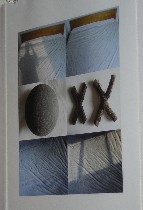 The art power-couple’s show of photographs are about their process and their world–the things that go into their artwork, but the large accumulation of examples turns the two bodies of work into personal statements. Moore’s got more than 500 photos on the wall in a tight, horizontal grid; Burns has nearly 100 sheets I’d guess, 6 photos collaged via computer on each sheet (a Burns collage, right).
The art power-couple’s show of photographs are about their process and their world–the things that go into their artwork, but the large accumulation of examples turns the two bodies of work into personal statements. Moore’s got more than 500 photos on the wall in a tight, horizontal grid; Burns has nearly 100 sheets I’d guess, 6 photos collaged via computer on each sheet (a Burns collage, right).The couple approached Midgett after she had stopped scheduling new exhibits, so the gallery was available. And Moore and Burns agreed to shoulder the burden of mounting the show in just about every way.
Their work is a departure for the Project Room, which has always specialized in more youthful work that stretches what art means. Midgett said Moore’s and Burns’ work fit the Project Room’s long-time mission to provide a creative space for shows that aren’t happening somewhere else. Certainly, these two groups of photographs are outside Burns’ and Moore’s usual art practice and have never been shown.
But after this show, Midgett said she was calling it quits, because it costs $500 to mount a show. “I can’t put out more money for the gallery,” she said. She’s also thinking about closing down the fabrication operation and studio next door, which, like all small businesses, is feast or famine. But it sounds like much of this is just thought. She’s dreaming of finding a job with regular pay and benefits; but so far, she said, she hasn’t really gotten down to brass tacks and begun the job hunt. She’s mulling over all the possibilities–full time, part time, teaching, consulting, etc., etc.
Meanwhile, she said she would be sad to lose the life she had set up, with the gallery and the art-making and fabrication and community-building integrated with one another.
This is not the first time Midgett has said she was going out of business. In Sept. 2002, she told Roberta she was leaving town, moving back to Virginia. Well, she’s still in town and still on North 8th Street. So I’m not sure how seriously to take this.
But it would be a loss for the city and its art community. Among the shows the Project Room brought us were installations from Mark Shetabi, a surround mural by David Guinn, video from Chicago artists, an installation by Kevin Reay, an installation by Astrid Bowlby, etc. etc.
Back to Moore and Burns
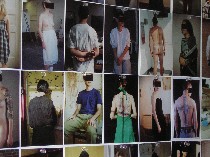 Moore’s photos (detail of installation, right) are snapshots of people of a variety of ages, sizes and genders, some dressed, some half-dressed, some undressed. The clothes range from swim suits to daily grunge to formal wear.
Moore’s photos (detail of installation, right) are snapshots of people of a variety of ages, sizes and genders, some dressed, some half-dressed, some undressed. The clothes range from swim suits to daily grunge to formal wear.What I enjoyed about the collection of bodies (the faces are generally not the subject here, and black tape over the eyes blocks identification of those facing forward) is how they stand in contrast to the bodies we are accustomed to seeing in images. Moore’s bodies are unprettied, unsexualized, just bodies. Everyone has flesh over bones, dimples in thighs; some people have sagging butts, some not. No one looks really beautiful (except for a couple of pregnant women). The images are less flattering than bodies in bathing suits on the beach. But like the beach bodies, these show humanity in its variety (not all its variety, but enough to get a sense of how little we look like fashion plates).
Even people who seemed to be thinking of themselves as sexy, projecting themselves as sexy, didn’t look sexy in these pictures, which have an unblinking documentary quality. Even the children look unbeautiful.
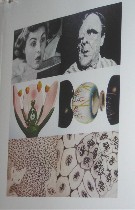 The photos are artifacts of Moore’s artwork, points of reference for when she’s painting. And that history reveals itself in the occasional paint splatters and brush marks on some of the photos. But what made the images interesting to me was their unsparing factualness.
The photos are artifacts of Moore’s artwork, points of reference for when she’s painting. And that history reveals itself in the occasional paint splatters and brush marks on some of the photos. But what made the images interesting to me was their unsparing factualness.
Burns’ photos are not byproducts (a detail from installation, left above). They are deliberate documentation of the world in which he lives. He’s been photographing his studio and what’s inside it, as well as his neighborhood, since June. The arrangement of the images on the page reminds me of the story-telling style of comic books–Burns’ metier. But for the most part, the combos are experimental and unresolved, with an equal emphasis on visual, formal relationships and on content/storytelling relationships.
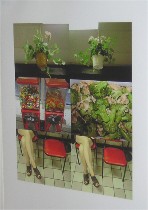 Some of the combos hit the mark, like the wrinkled sheets with x’s and an o-shaped rock, shadows and light tying the top bed photos to the bottom ones. I also liked one with a cartoon woman looking shocked as she reads in bed, a cartoon man with a scary face, a flower’s reproductive organs, a lamp turned sidewise to suggest a piston, and small organic shapes like eggs and sperm. Another combination that worked were green plants and legs, with a felicitous color combo and a slightly surreal sense of place (installation detail right).
Some of the combos hit the mark, like the wrinkled sheets with x’s and an o-shaped rock, shadows and light tying the top bed photos to the bottom ones. I also liked one with a cartoon woman looking shocked as she reads in bed, a cartoon man with a scary face, a flower’s reproductive organs, a lamp turned sidewise to suggest a piston, and small organic shapes like eggs and sperm. Another combination that worked were green plants and legs, with a felicitous color combo and a slightly surreal sense of place (installation detail right).









